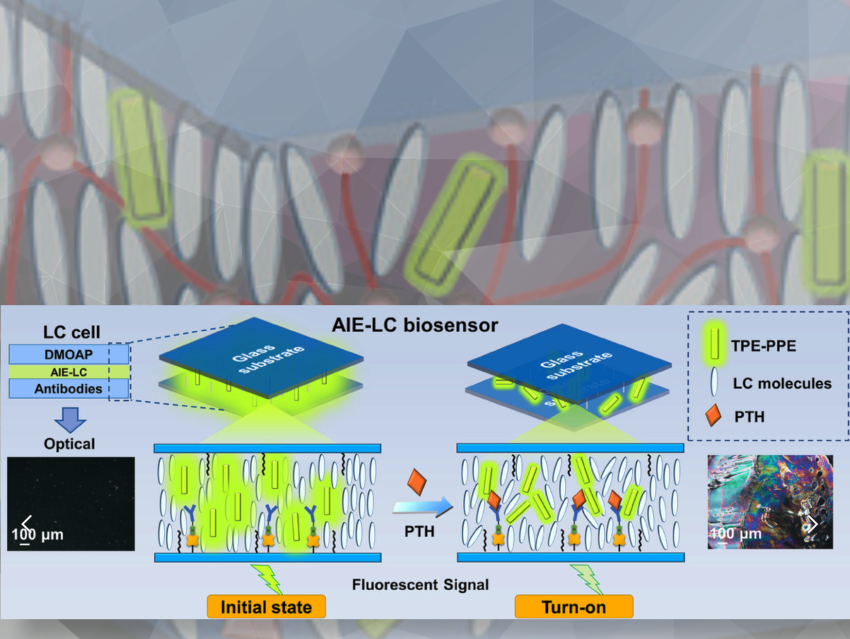Parathyroid hormone (PTH) is an important factor in maintaining blood calcium levels in the human body. Therefore, monitoring PTH levels is essential for assessing various diseases progression and managing overall health. However, most PTH assays require expensive markers, complex procedures, and well-trained personnel. Therefore, a simple, convenient, and visual method for detecting PTH is needed.
Liquid crystal (LC) biosensing technologies use the directional dependence of LC molecules’ properties (anisotropy) to detect biological molecules through orientation changes under stimuli, enabling sensitive, label-free detection. Aggregation-induced emission (AIE) is a phenomenon where fluorescence increases in aggregated molecules due to restricted intramolecular motion, enabling sensitive detection in bioassays.
Dongyu Zhao, Beihang University, China, Min Li, Huazhong University of Science and Technology, Wuhan, China, Ben Zhong Tang, The Chinese University of Hong Kong, Shenzhen (CUHK-Shenzhen), Guangdong, China, and colleagues have combined the strengths of LCs and AIE to achieve both qualitative and quantitative detection of PTH, using dual signal changes in both optical and fluorescence responses of AIE-LCs under orientational variation.
To create the aggregation-induced emissive liquid crystal photopolymer (AIE-LC-Poly) film, the team alkylated glass substrates with DMOAP/APTES (3-aminopropyl)trimethoxysilane/N,N-dimethyl-N-octadecyl(3-aminopropyl) trimethoxysilyl chloride) to ensure vertical alignment of the LC molecules. Streptavidin (SA) and biotin-conjugated PTH antibodies were then added to enable targeted detection of PTH.
Upon adding PTH, the alignment of the fluorescent LCs was disrupted, causing changes in both optical and fluorescence signals (pictured above). The photopolymer further amplified detection signals by enhancing the AIE effect of the fluorescent LCs in the initial state and increasing the disturbance of LCs’ ordered orientation upon PTH addition. Ultimately, the detection limit for PTH was reduced to 50 pg/mL.
This quantitative and sensitive AIE-LC-Poly biosensing technology paves the way for the development of LC-based sensors for biomedical applications without the need for labeling, according to the researchers.
- Aggregation Induced Emissive Liquid Crystals-Polymer Composite Membrane for Dual-Channel Analysis of Parathyroid Hormone,
Yingping Tong, Birong Wang, Dongyu Zhao, Min Li, and Ben Zhong Tang,
Aggregate 2025.
https://doi.org/10.1002/agt2.70000



